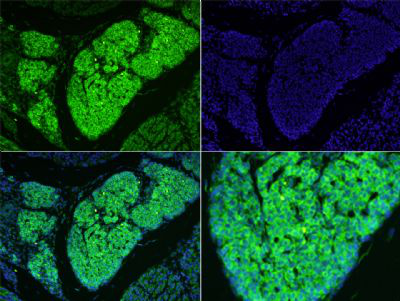产品货号 : mlR11028
英文名称 : MAP1B
中文名称 : 微管相关蛋白1B抗体
别 名 : FUTSCH; LC1; MAP5; MAP-1B; Microtubule associated protein 1B; Mtap1b; Mtap5; MAP1B_HUMAN.
研究领域 : 神经生物学 信号转导 细胞粘附分子 细胞类型标志物 细胞骨架
抗体来源 : Rabbit
克隆类型 : Polyclonal
交叉反应 : Human, Mouse, Rat, Dog, Pig, Cow, Horse, Rabbit, Sheep,
产品应用 : ELISA=1:500-1000 IHC-P=1:400-800 IHC-F=1:400-800 ICC=1:100-500 IF=1:100-500 (石蜡切片需做抗原修复)
not yet tested in other applications.
optimal dilutions/concentrations should be determined by the end user.
分 子 量 : 271kDa
细胞定位 : 细胞浆 细胞膜
性 状 : Lyophilized or Liquid
浓 度 : 1mg/ml
免 疫 原 : KLH conjugated synthetic peptide derived from human MAP1B:451-550/2468
亚 型 : IgG
纯化方法 : affinity purified by Protein A
储 存 液 : 0.01M TBS(pH7.4) with 1% BSA, 0.03% Proclin300 and 50% Glycerol.
保存条件 : Store at -20 °C for one year. Avoid repeated freeze/thaw cycles. The lyophilized antibody is stable at room temperature for at least one month and for greater than a year when kept at -20°C. When reconstituted in sterile pH 7.4 0.01M PBS or diluent of antibody the antibody is stable for at least two weeks at 2-4 °C.
PubMed : PubMed
产品介绍 : Microtubules, the primary component of the cytoskeletal network, interact with proteins called microtubule-associated proteins (MAPs). The microtubule-associated proteins can be divided into two groups, structural and dynamic. The structural microtubule-associated proteins, MAP-1A, MAP-1B, MAP-2A, MAP-2B and MAP-2C, stimulate tubulin assembly, enhance microtubule stability and influence the spatial distribution of microtubules within cells. Both MAP-1 and, to a greater extent, MAP-2 have been implicated as agents of microtubule depolymerization by suppressing the dynamic instability of the microtubules. The suppression of microtubule dynamic instability by the MAP proteins is thought to be associated with phosphorylation of the MAPs.
Function:
Microtubules are associated with a family of proteins called microtubule associated proteins (MAPs), which includes the protein t (tau) and a group of proteins referred to as MAP1, MAP2, MAP3, MAP4 and MAP5. MAP1B is the major microtubule associated protein in developing brain which changes its expression during development. In the newborn rat brain, it is a major component of microtubules but in the adult its level is ten fold lower. This change in the level of expression occurs simultaneously with neuronal maturation. MAP1B is the first MAP to appear in growing axons during development as it is present from the first emergence of the nascent axon from the cell body.
Subunit:
3 different light chains, LC1, LC2 and LC3, can associate with MAP1A and MAP1B proteins. LC1 interacts with the amino-terminal region of MAP1B. Interacts with ANP32A and TIAM2. Interacts with the tubulin tyrosine TTL. Interacts (via C-terminus) with GAN (via Kelch domains). Interacts (via N-terminus) with DAPK1.
Subcellular Location:
Cytoplasm, cytoskeleton. Cytoplasm. Cell junction, synapse. Cell projection, dendritic spine. Note=Colocalizes with DAPK1 in the microtubules and cortical actin fibers.
Post-translational modifications:
LC1 is generated from MAP1B by proteolytic processing.
S-nitrosylation at Cys-2464 enhances interaction with microtubules, and may act as an effector modification for neuronal nitric oxide synthase control of growth-cone size, growth-cone collapse and axon retraction.
Similarity:
Belongs to the MAP1 family.
SWISS:
P46821
Gene ID:
4131
Important Note:
This product as supplied is intended for research use only, not for use in human, therapeutic or diagnostic applications.
产品图片












